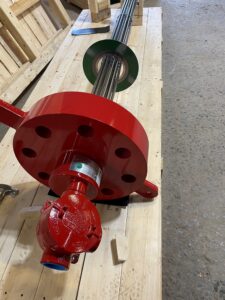Industrial Immersion Heaters
Last updated on November 17th, 2023 at 04:18 pm
An Overview of Different Types of Immersion Heaters
Immersion heaters are one of the most common heaters used in chemical, food, paint, and every industry in which intense heating and processing is required. These heaters are different than conventional heating systems because of their design and configuration. Following are some of the differences between normal and immersion heaters:
|
Convention Heaters |
Immersion Heaters |
| Conventional heaters usually have storage tanks, in which the heated medium can be stored temporarily. | Many immersion heaters are tankless or instantaneous, which means that the heated fluid will be directly transported to the system where it is required. |
| Conventional heaters cannot be attached directly to the system or vessel containing the fluid. | These heating systems can be a part of the tanks or vessels containing the fluid. |
| Heating through conventional heaters is time consuming. | Immersion heaters are also called instantaneous heaters. This is because they take considerably less time than convention heating systems to heat the same amount of fluid. |
Immersion heaters can be categorized into different types according to their construction and areas of application. Following are some of the commonly used industrial immersion heaters:
Flanged Immersion Heaters
 Flanged heaters consist of heating tubes bent and welded to the base of the heating plate. These through-the-side immersion heating systems are attached to the vessel in a fixed manner (usually welded). These heaters are usually used in high pressure gas vessels, boilers, food processing, cleaning tankers etc. although these heaters are precise, cleaning and maintenance of these systems is a bit tricky, as they cannot be detached from the vessel containing the fluid.
Flanged heaters consist of heating tubes bent and welded to the base of the heating plate. These through-the-side immersion heating systems are attached to the vessel in a fixed manner (usually welded). These heaters are usually used in high pressure gas vessels, boilers, food processing, cleaning tankers etc. although these heaters are precise, cleaning and maintenance of these systems is a bit tricky, as they cannot be detached from the vessel containing the fluid.
Over-the-Side Immersion Heaters
When it comes to construction and design, over-the side heaters are similar to flanged heaters. A difference between these two heating systems is; over-the-side heaters are used for tankless vessels which are directly routed to the system where the heated fluid is required. Whereas flanged immersion heaters are usually used in those industries where the fluid is stored before processing. As the name implies over-the-side heaters are attached (screwed or welded) over the top, and hanging along the side of the vessel.
Screw Plug Immersion Heaters
Unlike flanged or over-the-side heating systems, screw plug heaters consist of one up to six (6) heating tubes (some heaters contain more than one tubes but not as many as flanged and over-the-side heaters). The immersion heating system is usually mounted along the side, at the base of the tank through threaded coupling in the vessel. These immersion heaters are used in industries where intense heating is required in a small area. They are used in detergent manufacturing, and food processing industries.
Pipe Insert Immersion Heaters
These heaters are used to heat fluids indirectly and they serve the purpose of heating corrosive liquids using a pipe. The pipe heater is not in direct contact with the fluid and can be easily maintained without emptying the tank. These heaters can consist of a wither coil or rod-like heating elements which is first enclosed in atmospheric pressure and air tight bayonet pipe and then flanged into the tank.
Ilan Toledano is the Vice President of Marketing and Sales, North America, at Wattco, Quebec, Canada, a maker of electric heating elements and controls. To learn more from Wattco, call (800) 492-8826 or visit www.wattco.com.
